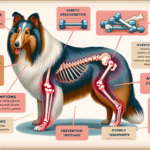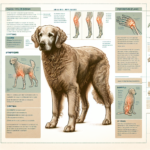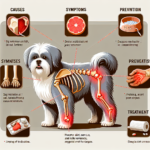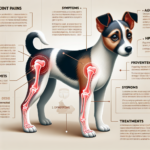Miniature Schnauzer Joint Pain: Causes, Symptoms, Prevention, and Treatment
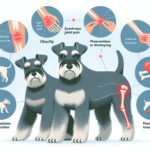
Introduction
The Miniature Schnauzer is a small, robust, and energetic breed known for its distinctive beard and eyebrows, giving it a wise and somewhat comical appearance. Originating in Germany in the late 19th century, this breed was initially developed as a farm dog, particularly for ratting and guarding. Miniature Schnauzers are characterized by their intelligence, alertness, and friendly nature, making them excellent companions and family pets.
While Miniature Schnauzers are generally healthy dogs, they are prone to certain health issues, including eye problems, skin disorders, and urinary stones. One significant concern for this breed is joint pain, which can severely impact their quality of life if not addressed promptly.
Joint health is crucial for Miniature Schnauzers due to their active nature and small size. Healthy joints allow them to maintain their agility and playful demeanor, which are key aspects of their personality. Understanding the causes, symptoms, prevention, and treatment of joint pain in Miniature Schnauzers is essential for ensuring their long-term well-being.
Breed-Specific Joint Pain Risks
Genetic Predisposition
Miniature Schnauzers, like many purebred dogs, have a genetic predisposition to certain joint-related issues. Hip dysplasia, a condition where the hip joint doesn’t fit properly into the hip socket, can occur in this breed, although it is less common than in larger breeds. Arthritis, an inflammation of the joints, is another concern, particularly as the dog ages. Elbow dysplasia, a developmental issue affecting the elbow joint, can also be seen in Miniature Schnauzers, though it is relatively rare.
Age-Related Risks
As Miniature Schnauzers age, the risk of joint pain increases. Typically, signs of joint issues may start to appear in middle age, around 5 to 7 years old. However, some dogs may show symptoms earlier or later, depending on their genetic makeup and lifestyle. It’s important for owners to be vigilant about their dog’s joint health as they age, watching for any signs of discomfort or mobility issues.
Activity Level and Joint Stress
Miniature Schnauzers are known for their high energy levels and love of play. While regular exercise is essential for their overall health, excessive or inappropriate activity can put stress on their joints. Activities that involve a lot of jumping or sudden stops and starts can be particularly hard on their joints. Owners should balance their dog’s need for exercise with the potential risk of joint stress, ensuring that activities are appropriate for their age and physical condition.
Common Symptoms of Joint Pain in Miniature Schnauzers
General Symptoms
- Limping: One of the most noticeable signs of joint pain is limping or favoring one leg over another.
- Stiffness: Dogs with joint pain may show stiffness, especially after resting or sleeping.
- Reluctance to Move: A dog in pain may be hesitant to jump, climb stairs, or even go for walks.
- Decreased Activity: A reduction in overall activity levels can indicate discomfort.
- Behavioral Changes: Irritability or changes in behavior can be a sign of chronic pain.
Breed-Specific Symptoms
In Miniature Schnauzers, joint pain may manifest in specific ways. Due to their small size, even slight changes in gait or activity levels can be more noticeable. Owners may observe their dog having difficulty getting up from a lying position or being less enthusiastic about playtime. Additionally, Miniature Schnauzers may show signs of pain through vocalizations such as whining or yelping when touched or moved.
When to Consult a Vet
If you notice any of the above symptoms in your Miniature Schnauzer, it’s important to consult a veterinarian promptly. Early intervention can prevent further deterioration and improve your dog’s quality of life. Persistent limping, noticeable pain, or significant changes in behavior should all be addressed by a professional.
Preventive Measures for Joint Health
Exercise Recommendations
Regular, moderate exercise is key to maintaining joint health in Miniature Schnauzers. Activities such as walking, swimming, and gentle play are excellent choices. Avoid high-impact activities like excessive jumping or running on hard surfaces. Tailor the exercise routine to your dog’s age and physical condition, gradually increasing intensity as appropriate.
Dietary Suggestions
A balanced diet rich in essential nutrients can support joint health. Look for dog foods that contain glucosamine and chondroitin, which help maintain cartilage. Omega-3 fatty acids, found in fish oil, can reduce inflammation and support joint function. Consult your veterinarian for specific dietary recommendations and consider supplements if necessary.
Weight Management
Maintaining a healthy weight is crucial for reducing joint stress. Excess weight puts additional pressure on the joints, exacerbating pain and discomfort. Monitor your dog’s weight regularly and adjust their diet and exercise routine as needed to keep them at an optimal weight.
Early Screening and Monitoring
Regular veterinary check-ups are essential for early detection of joint issues. Your vet may recommend specific screening tests, such as X-rays or joint fluid analysis, to identify problems before they become severe. Early intervention can significantly improve outcomes and quality of life for your Miniature Schnauzer.
Treatment Options for Joint Pain
Non-Surgical Treatments
Non-surgical treatments for joint pain include medications, physical therapy, and lifestyle adjustments. Anti-inflammatory drugs and pain relievers can provide relief, while physical therapy can improve mobility and strengthen muscles around the joints. Lifestyle changes, such as modifying exercise routines and providing supportive bedding, can also help manage pain.
Surgical Options
In severe cases, surgical intervention may be necessary. Common surgeries for joint pain include hip replacement, arthroscopy, and joint fusion. These procedures can provide significant relief and improve mobility, but they come with risks and require a recovery period. Consult with a veterinary orthopedic specialist to determine the best course of action for your dog.
Alternative Therapies
Alternative treatments such as acupuncture, hydrotherapy, and massage can also benefit Miniature Schnauzers with joint pain. Acupuncture can reduce pain and inflammation, while hydrotherapy provides low-impact exercise that strengthens muscles without stressing the joints. Massage can improve circulation and reduce muscle tension, providing relief from pain.
Lifestyle and Management Tips
Daily Care Routine
A consistent daily care routine can help manage joint pain in Miniature Schnauzers. This may include gentle exercise, administering medications or supplements, and providing a comfortable resting area. Regular grooming and nail trimming can also prevent additional strain on the joints.
Modifying the Home Environment
Making your home more comfortable for a dog with joint pain can significantly improve their quality of life. Consider using ramps instead of stairs, providing orthopedic beds, and ensuring that food and water bowls are easily accessible. Non-slip mats can also prevent falls and reduce the risk of injury.
Long-Term Management
Long-term management of joint pain involves ongoing monitoring and adjustments to your dog’s care routine. Regular veterinary check-ups, maintaining a healthy weight, and providing appropriate exercise are all essential components. Stay informed about new treatments and therapies that may benefit your dog, and be proactive in addressing any changes in their condition.
FAQs About Miniature Schnauzers and Joint Pain
What are the early signs of joint pain in Miniature Schnauzers?
Early signs of joint pain include limping, stiffness, reluctance to move, and decreased activity levels. Behavioral changes such as irritability or vocalizations when touched can also indicate pain.
Can joint pain in Miniature Schnauzers be prevented?
While genetic predispositions cannot be entirely prevented, maintaining a healthy weight, providing appropriate exercise, and ensuring a balanced diet can significantly reduce the risk of joint pain. Regular veterinary check-ups and early screening can also help catch issues early.
Are there specific exercises that are better for Miniature Schnauzers with joint pain?
Low-impact exercises such as walking and swimming are ideal for Miniature Schnauzers with joint pain. Avoid high-impact activities like jumping or running on hard surfaces. Tailor the exercise routine to your dog’s condition and consult your veterinarian for specific recommendations.
What dietary supplements can help with joint health in Miniature Schnauzers?
Supplements containing glucosamine, chondroitin, and omega-3 fatty acids can support joint health. These nutrients help maintain cartilage, reduce inflammation, and improve joint function. Consult your veterinarian before adding any supplements to your dog’s diet.
When should I consider surgery for my Miniature Schnauzer’s joint pain?
Surgery should be considered when non-surgical treatments are no longer effective, and your dog is experiencing significant pain or mobility issues. Consult with a veterinary orthopedic specialist to determine the best course of action for your dog’s specific condition.
Conclusion
Joint pain is a significant concern for Miniature Schnauzers, but with proper care and attention, it can be managed effectively. Understanding the causes, symptoms, prevention, and treatment options is essential for ensuring your dog’s long-term health and well-being. By taking preventive measures, providing appropriate care, and consulting with your veterinarian regularly, you can help your Miniature Schnauzer live a happy, active, and pain-free life.

